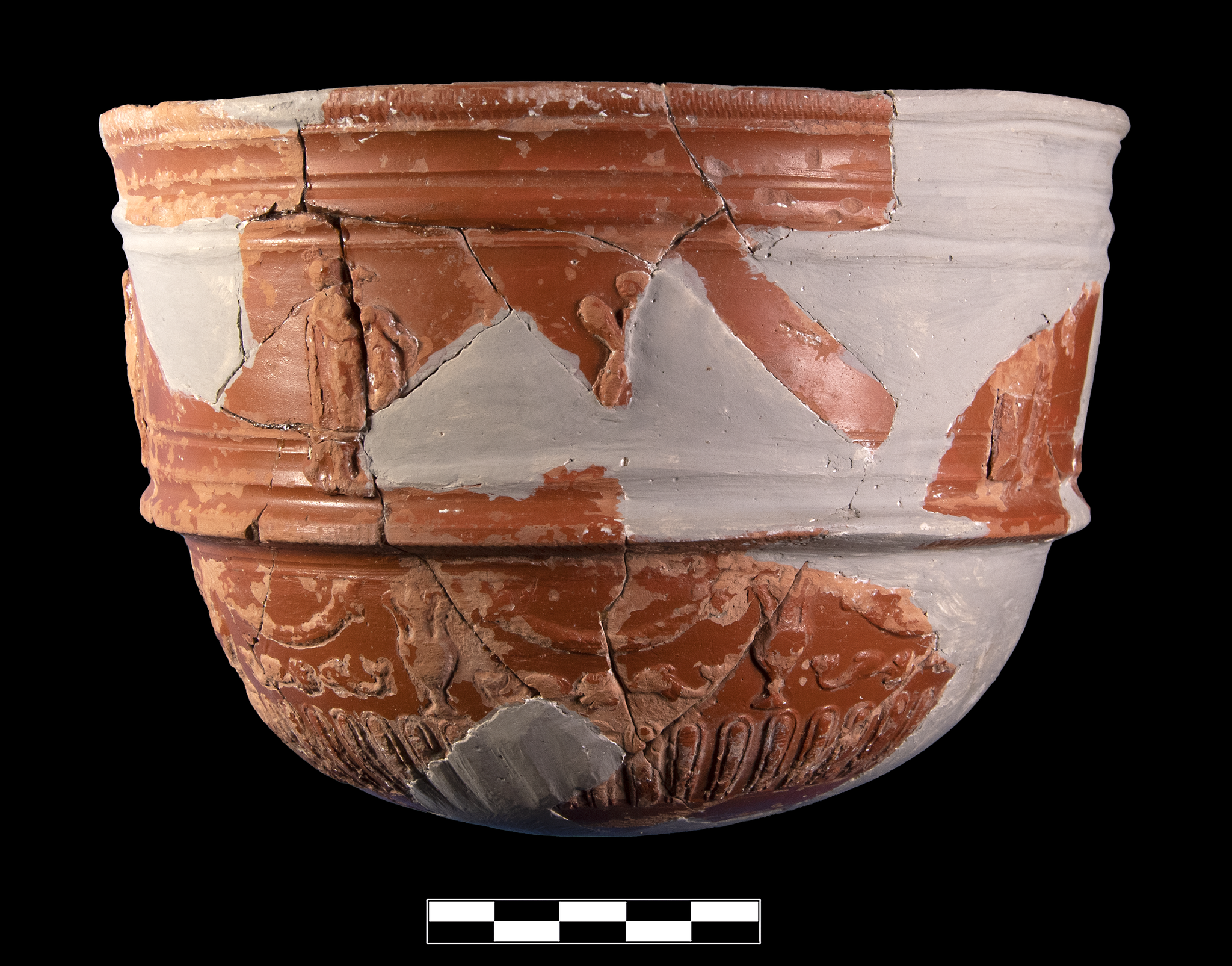- KE 1392 (Italian Sigillata Conspectus Form R 9.2) [permalink] [next]
- Type
- Inventoried Object
- Logical part of
- Chicago/Indiana/Vanderbilt Excavations Inventoried Objects
- Subject number
- P 373
- Typological identification
- Cult Practice
- Typological identification
- Italian Sigillata Conspectus Rim Form 9
- Typological identification
- Italian Sigillata with Molded Decoration
- Cited by
- SlaneWright1980b, p. 548 (rev. KenchreaiIV)
- Comparanda
- Form cf. Hayes1976a, pp. 13, 72, 92, no. 54, fig. 1, pl. 7 (“Krater ... apparently unique“; ROM)
- Conservation
- 1960s: sherds joined with shellac and infilling with fine plaster painted gray.
- Description
- Large chalice. Slightly flaring rim has rouletted bead at lip above convex band with rounded ridge below. Below is very nearly vertical band with appliqué decoration, then distinct flange as bowl curves to foot. Decorative band below flange. The following description of the decorative scheme is taken from KenchreaiIV: ”This Arretine bowl has both molded and applied decoration. The lowest zone consists of a calyx of molded tongues. The middle zone is divided into eight sections by appliqued amphoras. Each amphora is linked by a garland below which are two dolphins flanking a rosette. All these stamps are similar to those which are used as single applied motives on the vertical rims of plain Arretine vessels. The high vertical rim of the vessel is bordered by a rouletted moulding and bears two applique figures repeated a number of times at unequal intervals. Possibly the figures may be in four groups of two who face each other. Identification is hampered by the destruction of the surface from salt condensation. The male figure used is a stock type whose identification changes with the attributes which he holds. He is a nude youth with a cape hanging down at his back. He may be holding before himself a fruit festoon; in which case he is an Amorini type involved here in a ritual sacrifice. If the object he holds is a Dionysiac crook, he is a satyr involved in a Dionysiac procession. The other figure is a Lar in a short tunic holding up a cornucopia in his left hand and a possible situla in his right. Therefore, the likelihood is that the figures, a Genius or an Amor and a Lar are in groups of two, facing each other over an absent altar; and that they are involved in a ritual sacrifice.”
- Fabric, firing, surface
- Very fine light red fabric with no visible inclusions (though no breaks visible due to plaster in-fill). Dark red slip, glossy where best preserved.
- Preservation description
- 45 mostly joining sherds preserve ca. 50% of circumference of rim over at least two spans; ziplock bag of numerous small chips saved with vessel. Modern plaster infill obscures some joins. Profile of body is preserved down to near where the foot would have been attached, though no trace of that or of the foot itself remains. Sparse but consistent abrasion, scratching, and chipping especially around edges. Slip is well preserved except for frequent chips and wear, particularly over appliqués.
- Published as
- KenchreaiIV, no. ER 8, p. 50, pl. 13 (B. Adamsheck)
- Estimated body diameter
- 0.181
- Estimated height
- 0.1252
- Rim diameter
- 0.175
- Material
- Ceramic (Material)
- Has visual motif (depicts)
- Eros/Cupid (Visual Motif)
- Has visual motif (depicts)
- Satyr (Visual Motif)
- Fabric Munsell reading
- 10R 6/6 (light red)
- File
- Photograph
-

- Photograph
-

- Photograph
-

- Photograph
-

- Photograph
-

- Photograph
-

- Photograph
-

- Photograph
-
